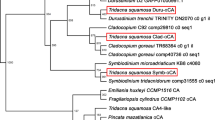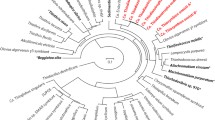Abstract
Carbonic anhydrase (CA) facilitates the rapid interconversion of carbon dioxide and bicarbonate. It is ubiquitous among organisms, and participates in numerous cellular processes. In several photoautotrophic marine organisms, CA facilitates uptake of inorganic carbon by catalyzing the reversible dehydration of bicarbonate to carbon dioxide, which diffuses more rapidly across cell membranes. In algal/invertebrate symbioses, this mechanism is correlated with significantly elevated CA activity in tissues where zooxanthellae are housed. Here, we determine whether elevated CA activity is also characteristic of tissues involved in inorganic carbon uptake by chemosynthetic invertebrates. Measurements of CA activity in several chemosynthetic clam and vestimentiferan species indicate that CA facilitates inorganic carbon uptake, with high activities present in clam gill tissue, and vestimentiferan plume and trophosome tissues. However levels of CA activity among species varied widely, from very low in mytilids to extraordinarily high in some vesicomyids and vestimentiferans. High CA activity is generally correlated with other adaptations for control of internal chemical environments where symbionts are housed, such as the presence of serum-borne sulfide-binding moieties. These findings suggest that a CA-based mechanism of carbon uptake may be one of a suite of adaptations to provide symbionts with essential metabolites.
Similar content being viewed by others
References
Aizawa K, Miyachi S (1986) Carbonic anhydrase and CO2 concentrating mechanisms in microalgae and cyanobacteria. Fedn eur microbiol Soc (FEMS) Microbiol Rev 39: 215–233
Anderson AE, Childress JJ, Favuzzi JA (1987) Net uptake of CO2 driven by sulfide and thiosulfate oxidation in the bacterial symbiont-containing clam Solemya reidi. J exp Biol 133: 1–31
Arp A, Childress JJ (1981) Blood function in the hydrothermal vent vestimentiferan tube worm. Science, NY 213: 342–344
Arp AJ, Childress JJ, Fisher CR Jr. (1984) Metabolic and blood gas transport characteristics of the hydrothermal vent bivalve, Calyptogena magnifica. Physiol Zoöl 57: 648–662
Childress JJ, Arp AJ, Fisher CR Jr (1984) Metabolic and blood characteristics of the hydrothermal vent tube-worm Riftia pachyptila. Mar Biol 83: 109–124
Childress JJ, Fisher CR (1992) The biology of hydrothermal vent animals: physiology, biochemistry, and autotrophic symbioses. Oceanogr mar biol A Rev 30: 337–441
Childress JJ, Fisher CR, Brooks JM, Kennicutt MC II, Bidigare R, Anderson A (1986) A methanotrophic marine molluscan symbiosis: mussels fueled by gas. Science, NY 233: 1306–1308
Childress JJ, Fisher CR, Favuzzi JA, Arp AJ, Oros DR (1993a) The role of a zinc-based, serum-borne sulphide-binding component in the uptake and transport of dissolved sulphide by the chemoautotrophic symbiont-containing clam Calyptogena elongata. J exp Biol 179: 131–158
Childress JJ, Fisher CR, Favuzzi JA, Kochevar RE, Sanders NK, Alayse AM (1991a) Sulfide-driven autotrophic balance in the bacterial symbiont-containing hydrothermal vent tubeworm, Riftia pachyptila Jones. Biol Bull mar biol Lab, Woods Hole 180: 135–153
Childress JJ, Fisher CR, Favuzzi JA, Sanders NK (1991b) Sulfide and carbon dioxide uptake by the hydrothermal vent clam, Calyptogena magnifica, and its chemoautotrophic symbionts. Physiol Zoöl 64: 1444–1470
Childress JJ, Lee RW, Sanders NK, Felbeck H, Oros DR, Toulmond A, Desbruyeres D, Kennicutt MC, Brooks J (1993b) Inorganic carbon uptake in hydrothermal vent tubeworms facilitated by high environmental pCO2. Nature, Lond 362: 147–149
Coleman JR, Berry JA, Togasaki RK, Grossman AR (1984) Identification of extracellular carbonic anhydrase of Chlamydomonas reinhardtii. Pl Physiol 76: 472–477
Doeller JE, Kraus DW, Colacino JM, Wittenberg JB (1988) Gill hemoglobin may deliver sulfide to bacterial symbionts of Solemya telum (Bivalvia, Mollusca). Biol Bull mar biol Lab, Woods Hole 175: 38–396
Fisher CR (1990) Chemoautotrophic and methanotrophic symbioses in marine invertebrates. CRC critical Rev aquat Sciences 2: 399–436
Fisher CR, Childress JJ, Arp AJ, Brooks JM, Distel D, Favuzzi JA, Felbeck H, Fritz LW, Hessler R, Johnson KS, Kennicutt MC II, Lutz RA, Macko SA, Newton A, Powell MA, Somero GN, Soto T (1988a) Microhabitat variation in the hydrothermal vent clam, Calyptogena magnifica, at Rose Garden vent on the Galapagos rift. Deep-Sea Res 35: 1811–1832
Fisher CR, Childress JJ, Arp AJ, Brooks JM, Distel D, Favuzzi JA, Felbeck H, Hessler R, Johnson KS, Kennicutt MC II, Macko SA, Newton A, Powell MA, Somero GN, Soto T (1988b) Microhabitat variation in the hydrothermal vent mussel Bathymodiolus thermophilus, at Rose Garden vent on the Galapagos rift. Deep-Sea Res 35: 1769–1792
Fisher CR, Childress JJ, Sanders NK (1988c) The role of vestimentiferan hemoglobin in providing an environment suitable for chemoautotrophic sulfide-oxidizing endosymbionts. Symbiosis 5: 229–246
Henry RP, Saintsing DG (1983) Carbonic anhydrase activity and ion regulation in three species of osmoregulating bivalve molluscs. Physiol Zoöl 56: 274–280
Hogetsu D, Miyachi S (1979) Role of carbonic anhydrase in photosynthetic CO2 fixation in Chlorella. Pl Cell Physiol, Tokyo 20: 747–756
Kochevar RE, Childress JJ, Fisher CR, Minnich L (1992) The methane mussel: roles of symbiont and host in the metabolic utilization of methane. Mar Biol 112: 389–401
Kochevar RE, Govind NS, Childress JJ (1983) Identification and characterization of two carbonic anhydrases from the hydrothermal vent tubeworm Riftia pachyptila Jones. Molec mar Biol Biotechnol 2: 10–19
Kraus DW, Wittenberg J (1990) Hemoglobins of the Lucina pectinata/bacteria symbiosis. I. Molecular properties, kinetics and equilibria of reactions with ligands. J biol Chem 265: 16043–16053
Lowry OH, Roseborough NJ, Farr AL, Randall RJ (1951) Protein measurement with the phenol reagent. J biol Chem 193: 265–275
Lucas WJ, Berry JA (1985) Inorganic carbon transport in aquatic photosynthetic organisms. Physiologia Pl 65: 539–543
Lutz RA, Fornari DJ, Haymon RM, Lilley MD, Von Damm KL, Desbruyeres D (1994) Rapid growth at deep-sea vents. Nature, Lond 371: 663–664
Mann T, Keilin D (1940) Sulphanilamide as a specific inhibitor of carbonic anhydrase. Nature, Lond 146: 164–165
Nielsen SA, Frieden E (1972) Carbonic anhydrase activity in molluses. Comp Biochem Physiol 41B: 461–468
O'Brien J, Vetter RD (1990) Production of thiosulfate during sulphide oxidation by mitochondria of the symbiont-containing bivalve Solemya reidi. J exp Biol 149: 133–148
Powell MA, Somero GN (1985) Sulfide oxidation occurs in the animal tissue of the gutless clam, Solemya reidi. Biol Bull mar biol Lab, Woods Hole 169: 164–181
Powell MA, Somero GN (1986) Hydrogen sulfide oxidation is coupled to oxidative phosphorylation in mitochondria of Solemya reidi. Science, NY 233: 563–566
Raven JA (1991) Implications of inorganic carbon utilization: ecology, evolution, and geochemistry. Can J Bot 69: 908–924
Scott KM, Fisher CR, Vodenichar JS, Nix ER, Minnich E (1994) Inorganic carbon and temperature requirements for autotrophic canbon fixation by the chemoautotrophic symbionts of the giant hydrothermal vent tube worm, Riftia pachyptila. Physiol Zoöl 67: 617–638
Terwilliger RC, Terwilliger NB, Arp AJ (1983) Thermal vent clam (Calyptogena magnifica) hemoglobin. Science, NY 219: 981–983
Vetter RD (1985) Elemental sulfur in the gills of three species of clams containing chemoautotrophic symbiotic bacteria: a possible inorganic energy storage compound. Mar Biol 88: 33–42
Weis VM (1991) The induction of carbonic anhydrase in the symbiotic sea anemone Aiptasia pulchella. Biol Bull mar biol Lab, Woods Hole 180: 496–504
Weis VM, Smith GJ, Muscatine L (1989) A “CO2 supply” mechanism in zooxanthellate enidarians: role of carbonic anhydrase. Mar Biol 100: 195–202
Wittenberg BA (1985) Oxygen supply to intracellular bacterial symbionts. Bull biol Soc Wash 6: 301–310
Yellowlees D, Dionisio-Sese ML, Masuda K, Maruyama T, Abe T, Baillie D, Tsuzuki M, Miyachi S (1993) Role of carbonic anhydrase in the supply of inorganic carbon to the giant clam-zooxanthellate symbiosis. Mar Biol 115: 605–611
Author information
Authors and Affiliations
Additional information
Communicated by M.F. Strathmann, Friday Harbor
Rights and permissions
About this article
Cite this article
Kochevar, R.E., Childress, J.J. Carbonic anhydrase in deep-sea chemoautotrophic symbioses. Marine Biology 125, 375–383 (1996). https://doi.org/10.1007/BF00346318
Received:
Accepted:
Issue Date:
DOI: https://doi.org/10.1007/BF00346318




